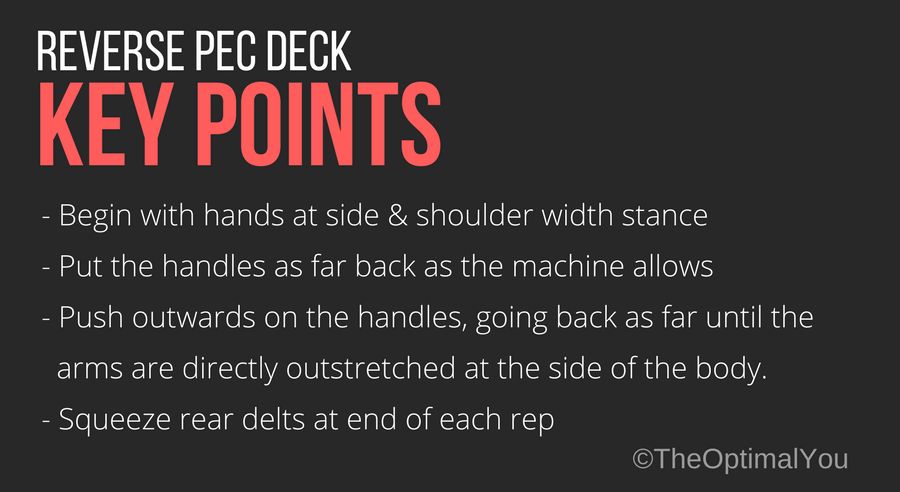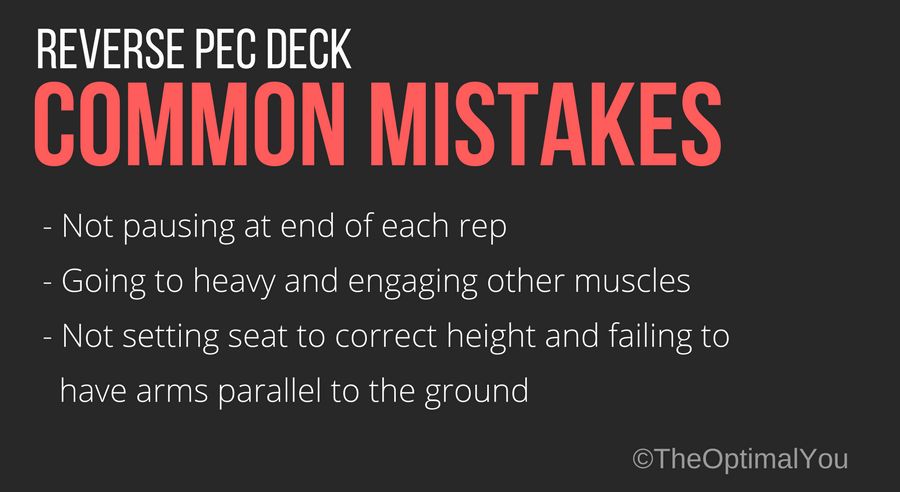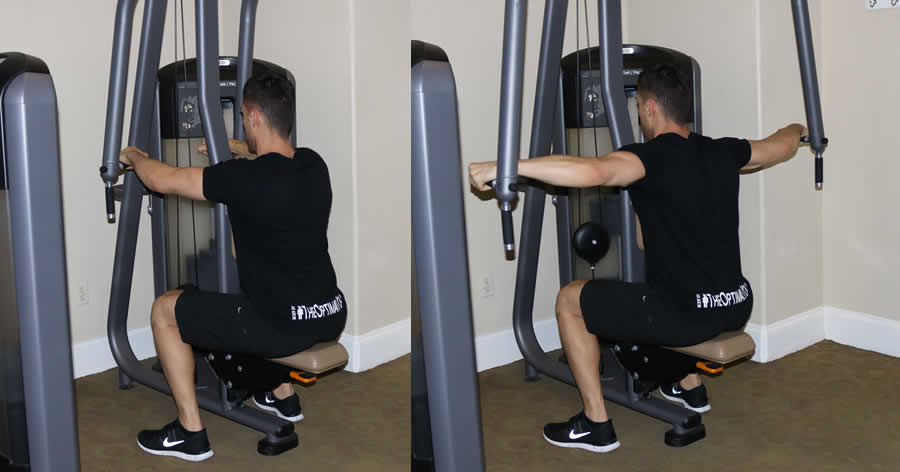Purpose of the Reverse Pec-Deck
The reverse pec-deck is an isolated machine exercise designed to target the rear deltoid muscles.
Equipment Needed to Perform the Reverse Pec-Deck
As you may expect, the only piece of equipment necessary to perform the reverse pec-deck would be a pec-deck that comes equipped with a setting to put the handles all the way back to next to where the weight stack sits.
Difficulty of the Reverse Pec-Deck
On a scale of 1 to 5, the reverse pec-deck would rank as a 2 – because it is a machine, it is very easy to stabilize your body, but the reason this exercise wouldn’t rank as low as a 1 is because it still requires the individual to focus hard on contracting the rear delts, or other muscles can begin to get involved and reduce the effectiveness of the exercise.
How to do the Reverse Pec-Deck
There are two adjustments to look out for when performing the reverse pec-deck – the height of the seat, and the range of motion for the handles.
Generally you want the seat high, or low enough, so that your hands are in line with your elbows, and also your shoulders when seated.
As for the range of motion, generally you want to put the handles as far back as possible, but should you want to limit the range for whatever reason, feel free to do so. Once the machine is set up to the right dimensions, have a seat, and grab onto the handles – palms facing each other.
Initiate the movement by pushing outwards onto the handles, going as far back until your upper arms are directly out to the side of your body – going farther is not necessary, even if you are able to.
Pause for 1-2 seconds when your arms are outstretched to the side of your body before slowly lowering the handles to the starting position, and repeat for as many repetitions as desired.
Key Points When Performing the Reverse Pec-Deck

- Set seat at appropriate height so hands, elbows, and shoulders are all in line when holding onto the handles.
- Set handles to allow for desired range of motion – generally a full range of motion is ideal, so put the handles as far back as the machine allows.
- Push outwards on the handles, going back as far until the arms are directly outstretched at the side of the body.
- Pause and squeeze rear delts before slowly lowering, pausing at the bottom, and repeating for the desired amount of reps.
How Many Reps When Performing the Reverse Pec-Deck
Because the reverse pec-deck is an isolated exercise designed to target muscles that a very large percentage of people have a hard time recruiting, it is not well suited for heavier weights and lower reps, but rather lighter weights and higher reps.
Most people would likely benefit by selecting a weight that allows for 10-15 reps to be performed.
Common Mistakes When Performing the Reverse Pec-Deck

Some of the more common mistakes when performing the reverse pec-deck are:
- Not pausing at end of each rep – a lot of people miss out on an opportunity to stimulate the rear delts when performing the reverse pec-deck by not pausing at the top, or bottom of the rep. Failure to do so can result in momentum being used advantageously to generate more reps at the expense of maximally stimulating the desired muscle.
- Going too heavy – because the rear delts are hard for most people to contract, what often happens is larger nearby muscles of the back can begin to take over, and thus the right amount of weight will feel too light. To compensate for this, naturally one would increase the weight, but this doesn’t increase the demand on the targeted muscle, but rather increases the demand on the muscles best suited to take on the stress.
- Not setting seat to correct height and failing to have arms parallel to the ground
Modifications to the Reverse Pec-Deck
There aren’t really any worthwhile modifications to the reverse pec-deck, aside from playing with hand positioning – both height, and grip.
Play around with hand positioning to see what you feel best, but don’t obsess over it, as there’s no universally “better” way than the more common, traditional way described above in the “how to do” section.
When to do the Reverse Pec-Deck
Depending on your goal, you can perform the reverse pec-deck pretty much anywhere in either a shoulder workout, or back workout.
There are benefits to using this exercise early, as well as late in a workout, so your goal should determine more than anything where in sequence you use this exercise.
Alternatives to The Reverse Pec-Deck
There are a few different effective alternatives to the reverse pec-deck, among them being – bent-over lateral raises, and reverse cable flyes.
The Reverse Pec-Deck vs. Seated Bent Over Lateral Raise
The primary advantage of the reverse pec-deck over the seated bent over lateral raise is that the tension being placed on the muscles remains consistent throughout the entire range of motion, whereas with a cable, or pair of dumbbells, the resistance felt will be maximized only when the direction of effort is perpendicular to your arms.
Generally with a pair of dumbbells, or when using cables, the resistance is greatest when the rear delts are in a shortened position, meaning they aren’t effectively overloaded when they are in a more lengthened position – with the reverse pec-deck, you don’t have to consider this.
The primary disadvantage is the reverse pec-deck is a lot less practical, as some gyms may not have this machine, but nearly all gyms will have dumbbells, and most will have cables to use.
Here’s The Next Step…
Are you ready to use the one of the routines from this post?
If so, then we recommend grabbing the free checklist we made just for this blog post.
The checklist takes you step by step to show you how to use all of the plans listed here…
…plus 2 bonus techniques that I didn’t have room for in today’s post.
Enter your name and email to access the checklist.
[content name=cta]

